小学英语语法——形容词副词
- 格式:doc
- 大小:29.50 KB
- 文档页数:2

小学英语语法形容词副词的用法总结整理归纳形容词是用来描述事物的特征和性质的词语,而副词则用来描述动作的方式、程度、时间等。
下面是小学英语形容词和副词的用法总结:形容词的用法:1. 形容词一般置于名词之前,用来修饰名词。
例如:a big house (一座大房子),a happy girl(一个快乐的女孩)。
2. 形容词可以用于比较级和最高级。
比较级用来比较两个事物的不同,最高级用来比较三个或以上事物的不同。
例如:This book is bigger than that one(这本书比那本大);He is the tallest boy in the class(他是班级里最高的男孩)。
3. 形容词可以和"be"动词连用,表示事物的状态或性质。
例如:She is beautiful(她很漂亮)。
副词的用法:1. 副词可以修饰动词,表示动作的方式、程度等。
例如:He runs quickly(他跑得很快)。
2. 副词可以修饰形容词,表示形容词程度的大小。
例如:She is very beautiful(她非常漂亮)。
3. 副词可以修饰其他副词,表示副词的程度。
例如:He reads quite slowly(他读得相当慢)。
4. 副词也可以修饰整个句子,表示说话人的态度或观点。
例如:Certainly, I will help you(当然,我会帮助你)。
需要注意的是,有一些形容词和副词的形式是相同的,需要根据具体情况来判断其词性。
同时,有些形容词和副词可以通过在词尾加上"-ly"来转化为副词形式。
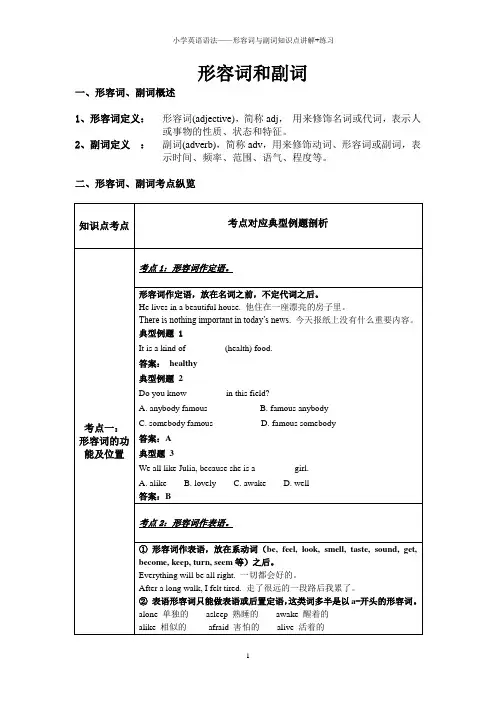
形容词和副词一、形容词、副词概述1、形容词定义:形容词(adjective),简称adj,用来修饰名词或代词,表示人或事物的性质、状态和特征。
2、副词定义:副词(adverb),简称adv,用来修饰动词、形容词或副词,表示时间、频率、范围、语气、程度等。
二、形容词、副词考点纵览三、综合练习( ) 1. How beautifully she sings! I have never heard _____ voice.A. a betterB. a bestC. the betterD. the best ( ) 2. She looks very _____ but I can’t remember her name.A. similarB. familiarC. friendlyD. strange ( ) 3. Children all looked _____ at the broken model plane and felt quite _____.A. sad; sadB. sadly; sadlyC. sad; sadlyD. sadly; sad( ) 4. The child dreamed that he had once lived in a _______ house in the forest.A. wooden pretty littleB. little pretty woodenC. pretty little woodenD. wooden little pretty( ) 5. ---Which team is _______ to win the game?---I don’t know, but I’ve found _______ for ours to win.A. probable; it unlikelyB. likely; it possibleC. possible; it possibleD. likely; it possibly( ) 6. With the development of the Internet, _______ communication is done by regular mail.A. lessB. moreC. littleD. few( ) 7. ---If you don’t like the red coat, take the blue one.---OK, but do you have ______ size in blue? This one’s a bit tight for me.A. a bigB. a biggerC. the bigD. the bigger( ) 8. If there were no examinations, we should have ______ at school.A. the happiest timeB. a more happier timeC. much happiest timeD. a much happier time( ) 9. This dress is prettier, but it costs ______ that one.A. twice more thanB. twice as much asC. as much twice asD. twice so much as( ) 10.________students are required to take part in the boat race.A. Ten strong young ChineseB. Ten Chinese strong youngC. Chinese ten young strongD. Young strong ten Chinese( ) 11. Allen had to call a taxi because the box was ____to carry all the way home.A. much too heavyB. too much heavyC. heavy too muchD. too heavy much( ) 12. Our neighbor has ________ours.A. as a big house asB. as big a house asC. the same big house asD. a house the same big as( ) 13. We were in ________when we left that we forgot the airline tickets.A. a rush so anxiousB. a such anxious rushC. so an anxious rushD. such an anxious rush( ) 14. ---I was riding along the street and all of a sudden, a car cut in and knocked me down.---You can never be ________careful in the street.A. muchB. veryC. soD. too( ) 15. ---You don’t look very ________.Are you ill?---No,I’m just a bit tired.A. goodB. wellC. strongD. healthy( ) 16. Four of Robert’s children were at the party,including ________, Luke.A. the eldestB. an oldest oneC. the oldD. an old one( ) 17. Many students signed up for the ________race in the sports meeting to be held next week.A. 800-metre-longB. 800-metres-longC. 800 metre lengthD. 800 metres length( ) 18. It’s always difficult being in a foreign country,________if you don’t speak the language.A. extremelyB. naturallyC. basicallyD. especially( ) 19. In recent years,travel companies have succeeded in selling us the idea that the further we go,__________.A. our holiday will be betterB. our holiday will be the betterC. the better our holiday will beD. the better will our holiday be( ) 20. When he heard a cry for help, he ran out as ________ as he could.A. hardlyB. quicklyC. finallyD. slowly( ) 21. “Our team is _____ to win the match.” “Really? But I don’t think so.”A. easyB. difficultC. possibleD. sure( ) 22. A ______ road goes ______ from one place to another.A. straight; straightB. straightly; straightlyC. straight; straightlyD. straightly; straight( ) 23. “This book is ______ more useful for us students.” “Yes, but it is _______ too difficult.”A. quite; quiteB. much; ratherC. rather; quite D quite; much( ) 24. There was a ______ change in the weather, and the rain came pouring down.A. quickB. slowC. fastD. sudden( ) 25. You can speak ______ in front of him, but you can’t eat ______ in his restaurant.A. freely; freelyB. free; freelyC. freely; freeD. free; free( ) 26. Tom will not be at the picnic, ______ to the family’s disappointment.A. muchB. moreC. too muchD. much more( ) 27. --- I have seen so little of Mike ______. Is he away on business?--- Oh, no. He just leaves for his office early and comes back very ______.A. later; latelyB. later; laterC. lately; lateD. late; lately( ) 28. From his ______ voice on the phone I know everything is well under way.A. satisfactoryB. satisfyingC. satisfiedD. satisfaction( ) 29. In ______ Chinese culture, marriage decisions were often made by parents for their children.A. traditionalB. historicC. peacefulD. civil( ) 30. The houses in the village are ______ built of wood and hay.A. mostB. almostC. nearlyD. mostly( ) 31. --- What do people wear when they go to the theatre?--- Well, it isn’t very ______. People can wear anything they like.A. normalB. certainC. modernD. simple( ) 32. Mary’s biology is ______ than ______ in the class.A. a lot of better; anyone else’sB. far better; anyone’s else’sC. much better; anyone elseD. a lot better; anyone else’s( ) 33. We decided not to climb the mountains because it was raining ____.A. badlyB. hardlyC. stronglyD. heavily( ) 34. Paris is one of _____ cities in the world.A. more beautifullyB. more beautifulC. the most beautifullyD. the most beautiful ( ) 35. Are you going to leave______?A. the open windowsB. the windows openingC. the windows openD. the windows opened( ) 36. Bob never does his homework _____ Mary, so he makes lots of mistakes.A. so careful asB. as carefully asC. carefully asD. as careful as.( ) 37. My sister is good at sports. She can jump ____ than me.A. highestB. very highC. too highD. much higher ( ) 38. When spring comes, the trees get ____.A. green and greenB. green and greenerC. greener and greenD. greener and greener( ) 39.He works very ___________.He _____________has a rest on Sundays.A. hard; hardlyB. hardly; hardC. hard; hardD. hardly; hardly( ) 40.He learns Russian_____________.A. goodB. niceC. wellD. fine( ) 41.The boy didn’t run______________ to catch the bus.A. fast enoughB. enough fastC. quick enoughD. enough quickly ( ) 42.Eating _____________ is bad for our health.A. much tooB. too muchC. too moreD. too many( ) 43.Have you ever seen ______________ big panda before?A. a suchB. such aC. so aD. as( ) 44.He looks very _____________ today.A. worriedB. worryC. worryingD. to worry( ) 45.Listen to me. I have _____________ to tell you.A. important somethingB. important anythingC. something importantD. anything important( ) 46. ---How ___ can you finish the drawing?--- In ten minutes.A. longB. often.C. soonD. rapid( ) 47. This book is _____ worth seeing again.A. veryB. quiteC. wellD. much( ) 48. My _____ brother is three years ____ than I .A. old; olderB. elder; olderC. older; elderD. old; elder( ) 49. We felt ___ after we watched the ___ football match.A. exciting; excitedB. excited; excitingC. excited; excitedD. exciting; exciting( ) 50. The old man lived ____ in the house, but he didn’t feel___.A. lonely; lonelyB. alone; lonelyC. alone; aloneD. lonely; alone小学英语语法——形容词与副词知识点讲解+练习参考答案1. A2.B3.D4.C5.B6.A7.B8.D9.B 10.A 11. A 12.B 13.D 14.D 15.B 16.A 17.A 18.D 19.C 20.B 21. D 22.A 23.B 24.D 25.C 26.A 27.C 28.C 29.A 30.D 31. B 32.D 33.D 34.D 35.C 36.B 37.D 38.D 39.A 40.C 41. A 42.B 43.B 44.A 45.C 46.C 47.C 48.B 49.B 50.B11。
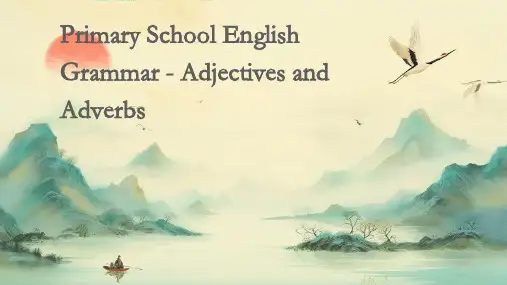
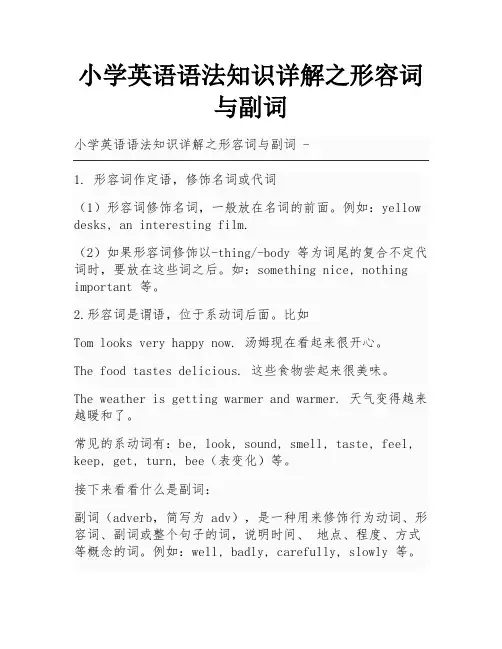
小学英语语法知识详解之形容词与副词1. 形容词作定语,修饰名词或代词(1)形容词修饰名词,一般放在名词的前面。
例如:yellow desks, an interesting film.(2)如果形容词修饰以-thing/-body 等为词尾的复合不定代词时,要放在这些词之后。
如:something nice, nothing important 等。
2.形容词是谓语,位于系动词后面。
比如Tom looks very happy now. 汤姆现在看起来很开心。
The food tastes delicious. 这些食物尝起来很美味。
The weather is getting warmer and warmer. 天气变得越来越暖和了。
常见的系动词有:be, look, sound, smell, taste, feel, keep, get, turn, bee(表变化)等。
接下来看看什么是副词:副词(adverb,简写为 adv),是一种用来修饰行为动词、形容词、副词或整个句子的词,说明时间、地点、程度、方式等概念的词。
例如:well, badly, carefully, slowly 等。
(对于什么是副词,也同样是运用跟汉语相联系的办法,前面说形容词就是带“的”的词,那么副词就是带“地”或者“得”的词了,我们知道在汉语中带“地”的词后面都是接动词,也就意味着英语中汉语解释带“地”的词也是用来修饰动词的,这样既可以很好的理解什么是副词也能顺便把副词的基本用法了解了,一举两得。
对于带“得”的词,在汉语中一般是接形容词的,比如说:开心得不得了,可以看得出“开心”是形容词,而“不得了”是修饰开心的程度的,于是中文含义带有“得”的词就是副词,且是用来修饰形容词或者副词的程度的)副词的分类方式副词: 表示动作和状态的进行和存在方式、方法,如:carefully, suddenly, fast, well, politely,但friendly lovely, lonely, lively elderly, ugly 为形容词程度副词: 多用来修饰形容词和副词,如:very ,much,enough,almost,rather,so,too,still,quite地点副词:here ,there ,everywhere, anywhere, home, upstairs, downstairs 等时间副词:tomorrow, now, today, then, yesterday, tonight 等频度副词:always,usually,often,never,sometimes,seldom,once,rarely,hardly 等疑问副词:why, when, where, how(引导特殊疑问句) how often, how long ,how soon, how much, how many 等关系副词:when, where, why (用于定语从句)其他also,either,too,only,perhaps(对于疑问副词和关系副词,小学不用做要求,认识就行!)接下来看看副词的基本用法:(1)修改行为动词以显示动作是如何执行的。
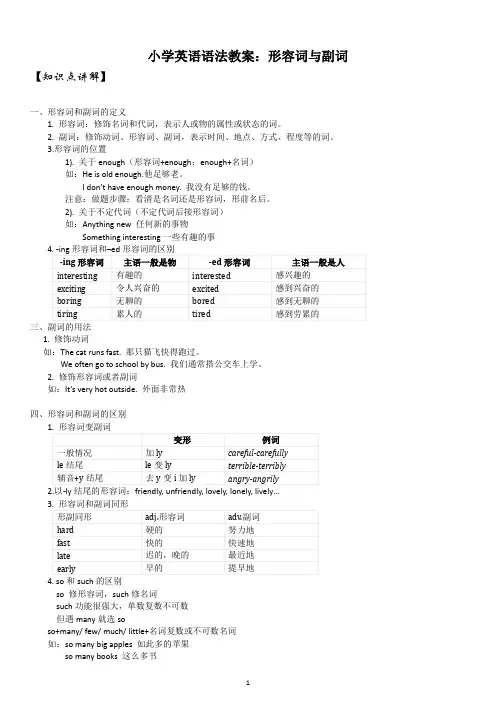
小学英语语法教案:形容词与副词【知识点讲解】一、形容词和副词的定义1. 形容词:修饰名词和代词,表示人或物的属性或状态的词。
2. 副词:修饰动词、形容词、副词,表示时间、地点、方式、程度等的词。
3.形容词的位置1). 关于enough(形容词+enough;enough+名词)如:He is old enough.他足够老。
I don’t have enough money. 我没有足够的钱。
注意:做题步骤:看清是名词还是形容词,形前名后。
2). 关于不定代词(不定代词后接形容词)如:Anything new 任何新的事物Something interesting一些有趣的事三、副词的用法1. 修饰动词如:The cat runs fast. 那只猫飞快得跑过。
We often go to school by bus. 我们通常搭公交车上学。
2. 修饰形容词或者副词如:It’s very hot outside. 外面非常热四、形容词和副词的区别2.以-ly结尾的形容词:friendly, unfriendly, lovely, lonely, lively…4. so和such的区别so 修形容词,such修名词such功能很强大,单数复数不可数但遇many就选soso+many/ few/ much/ little+名词复数或不可数名词如:so many big apples 如此多的苹果so many books 这么多书so few people 这么少的人so much money 那么多的钱so little milk 那么少的牛奶五、形容词副词的原级、比较级和最高级六、形容词副词的原级、比较级和最高级用法1. 原级形容词的本来形式就是形容词的原级。
1). “as…as”结构,表示“前者像后者一样”,A+do+as+adj./ adv. +as+B (+do).如:John is as tall as his brother. 约翰和他的哥哥一样高。
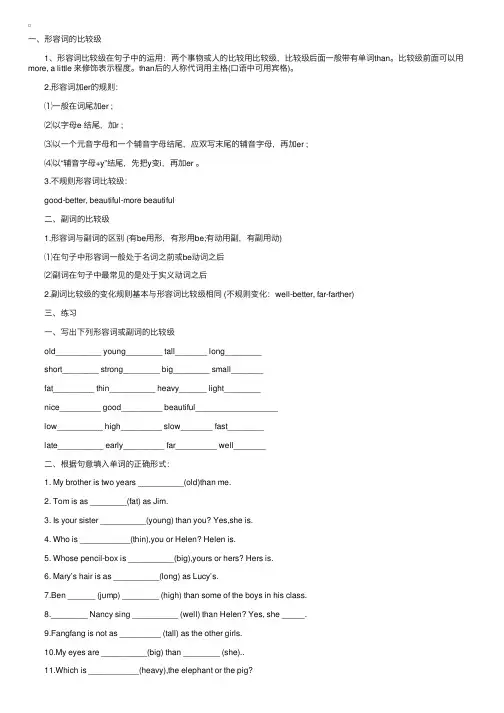
⼀、形容词的⽐较级 1、形容词⽐较级在句⼦中的运⽤:两个事物或⼈的⽐较⽤⽐较级,⽐较级后⾯⼀般带有单词than。
⽐较级前⾯可以⽤more, a little 来修饰表⽰程度。
than后的⼈称代词⽤主格(⼝语中可⽤宾格)。
2.形容词加er的规则: ⑴⼀般在词尾加er ; ⑵以字母e 结尾,加r ; ⑶以⼀个元⾳字母和⼀个辅⾳字母结尾,应双写末尾的辅⾳字母,再加er ; ⑷以“辅⾳字母+y”结尾,先把y变i,再加er 。
3.不规则形容词⽐较级: good-better, beautiful-more beautiful ⼆、副词的⽐较级 1.形容词与副词的区别 (有be⽤形,有形⽤be;有动⽤副,有副⽤动) ⑴在句⼦中形容词⼀般处于名词之前或be动词之后 ⑵副词在句⼦中最常见的是处于实义动词之后 2.副词⽐较级的变化规则基本与形容词⽐较级相同 (不规则变化:well-better, far-farther) 三、练习 ⼀、写出下列形容词或副词的⽐较级 old__________ young________ tall_______ long________ short________ strong________ big________ small_______ fat_________ thin__________ heavy______ light________ nice_________ good_________ beautiful__________________ low__________ high_________ slow_______ fast________ late__________ early_________ far_________ well_______ ⼆、根据句意填⼊单词的正确形式: 1. My brother is two years __________(old)than me. 2. Tom is as ________(fat) as Jim. 3. Is your sister __________(young) than you? Yes,she is. 4. Who is ___________(thin),you or Helen? Helen is. 5. Whose pencil-box is __________(big),yours or hers? Hers is. 6. Mary’s hair is as __________(long) as Lucy’s. 7.Ben ______ (jump) ________ (high) than some of the boys in his class. 8.________ Nancy sing __________ (well) than Helen? Yes, she _____. 9.Fangfang is not as _________ (tall) as the other girls. 10.My eyes are __________(big) than ________ (she).. 11.Which is ___________(heavy),the elephant or the pig? 12.Who gets up _________(early),Tim or Tom? 13._____the girls get up_______(early) than the boys?No,they______. 14. Jim runs _____(slow). But Ben runs _____(slow). 15.The child doesn’t______(write) as ____(fast) as the students. 三、翻译句⼦: 1、谁⽐Jim年纪⼤?是你。

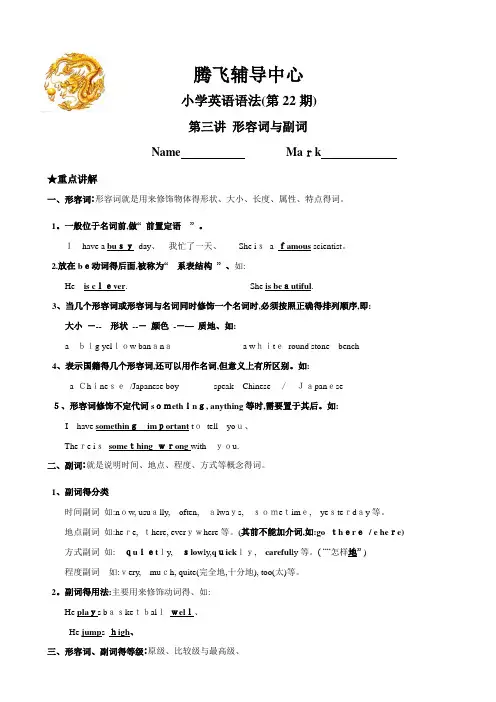
腾飞辅导中心小学英语语法(第22期)第三讲形容词与副词Name Mark★重点讲解一、形容词:形容词就是用来修饰物体得形状、大小、长度、属性、特点得词。
1。
一般位于名词前,做“ 前置定语” 。
Ihave a busyday、我忙了一天、She isa famous scientist。
2.放在be动词得后面,被称为“系表结构” 、如:He is clever. She is beautiful.3、当几个形容词或形容词与名词同时修饰一个名词时,必须按照正确得排列顺序,即:大小---形状---颜色--—质地、如:abig yellow banana a whiteround stone bench4、表示国籍得几个形容词,还可以用作名词,但意义上有所区别。
如:a Chinese/Japanese boy speak Chinese/Japanese5、形容词修饰不定代词something, anything等时,需要置于其后。
如:I have somethingimportant totell you、There issomething wrong withyou.二、副词:就是说明时间、地点、程度、方式等概念得词。
1、副词得分类时间副词如:now, usually,often,always,sometime,yesterday等。
地点副词如:here, there, everywhere等。
(其前不能加介词,如:go there/ e here)方式副词如:quietly,slow ly,quickly,careful ly等。
( ““怎样地” )程度副词如:very,much, quite(完全地,十分地), too(太)等。
2。
副词得用法:主要用来修饰动词得、如:He plays basketballwell、He jump shigh、三、形容词、副词得等级:原级、比较级与最高级、1、原级得用法肯定句:主语+ be动词+as + 原级+as 。
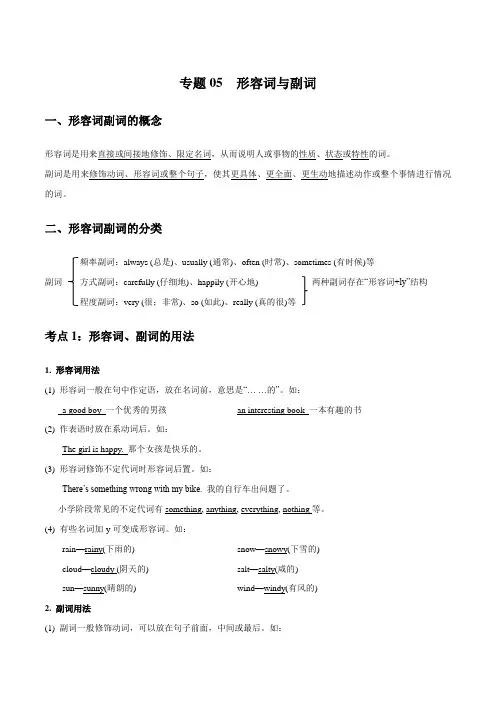
专题05 形容词与副词一、形容词副词的概念形容词是用来直接或间接地修饰、限定名词,从而说明人或事物的性质、状态或特性的词。
副词是用来修饰动词、形容词或整个句子,使其更具体、更全面、更生动地描述动作或整个事情进行情况的词。
二、形容词副词的分类频率副词:always (总是)、usually (通常)、often (时常)、sometimes (有时候)等副词方式副词:carefully (仔细地)、happily (开心地) 两种副词存在“形容词+ly”结构程度副词:very (很;非常)、so (如此)、really (真的很)等考点1:形容词、副词的用法1. 形容词用法(1) 形容词一般在句中作定语,放在名词前,意思是“… …的”。
如:a good boy 一个优秀的男孩an interesting book 一本有趣的书(2) 作表语时放在系动词后。
如:The girl is happy. 那个女孩是快乐的。
(3) 形容词修饰不定代词时形容词后置。
如:There’s something wrong with my bike.我的自行车出问题了。
小学阶段常见的不定代词有something, anything, everything, nothing等。
(4) 有些名词加-y可变成形容词。
如:rain—rainy(下雨的) snow—snowy(下雪的)cloud—cloudy (阴天的) salt—salty(咸的)sun—sunny(晴朗的) wind—windy(有风的)2. 副词用法(1) 副词一般修饰动词,可以放在句子前面,中间或最后。
如:They live happily.他们幸福地生活着。
(happily 快乐地,幸福地,修饰动词live)They are listening to the teacher carefully. 他们在认真地听老师讲。
(carefully 认真地,修饰动词listen)温馨提示:连系动词不用副词修饰,直接加形容词作表语。
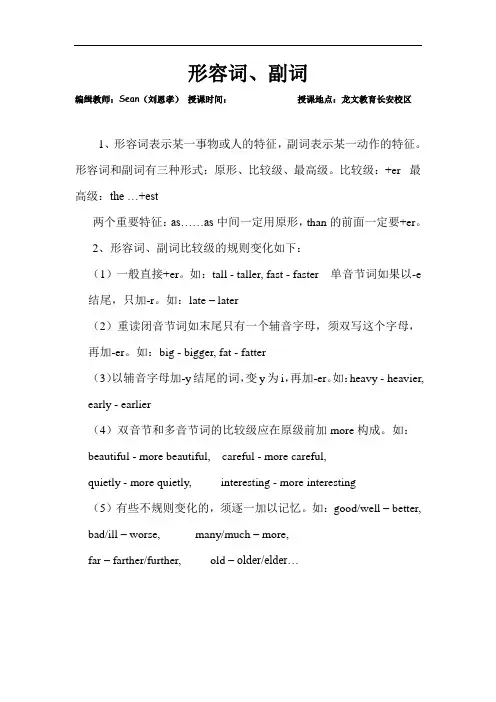
形容词、副词编缉教师:Sean(刘恩孝)授课时间:授课地点:龙文教育长安校区1、形容词表示某一事物或人的特征,副词表示某一动作的特征。
形容词和副词有三种形式:原形、比较级、最高级。
比较级:+er 最高级:the …+est两个重要特征:as……as中间一定用原形,than的前面一定要+er。
2、形容词、副词比较级的规则变化如下:(1)一般直接+er。
如:tall - taller, fast - faster 单音节词如果以-e 结尾,只加-r。
如:late – later(2)重读闭音节词如末尾只有一个辅音字母,须双写这个字母,再加-er。
如:big - bigger, fat - fatter(3)以辅音字母加-y结尾的词,变y为i,再加-er。
如:heavy - heavier, early - earlier(4)双音节和多音节词的比较级应在原级前加more构成。
如:beautiful - more beautiful, careful - more careful,quietly - more quietly, interesting - more interesting(5)有些不规则变化的,须逐一加以记忆。
如:good/well – better, bad/ill – worse, many/much – more,far – farther/further, old –older/elder…形容词、副词练一练:全卷满分:拟题人:Sean(刘恩孝)拟题时间:1、写出下列形容词、副词的比较级。
big good longtall old short t hin heavy youngfat light stronghigh far lowearly late wellfast slow2、用括号内所给单词的适当形式填空。
1) I can swim as _______ ( fast ) as the fish, I think.2) Look! His hands are _______ ( big ) than mine.3) I think you do these things_______ ( well ) than your classmates.4) Whose bag is _______ ( heavy ), yours or mine?5) Does Jim run as _______(slow ) as David? Yes, but Mikeruns_______ ( slow ) than them.6) You have seven books, but I have _______ ( many ) than you.I have ten.7) I jump _______ ( far ) than some of the boys in my class.8) I’m very_______ ( thin ), but she’s _______ ( thin ) than me.9) It gets _______and_______ ( warm ) when spring comes here.。
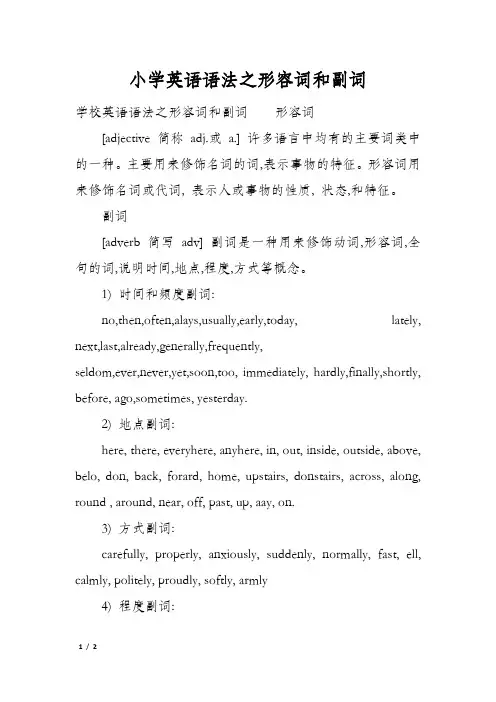
小学英语语法之形容词和副词学校英语语法之形容词和副词形容词[adjective 简称adj.或a.] 许多语言中均有的主要词类中的一种。
主要用来修饰名词的词,表示事物的特征。
形容词用来修饰名词或代词, 表示人或事物的性质, 状态,和特征。
副词[adverb简写adv] 副词是一种用来修饰动词,形容词,全句的词,说明时间,地点,程度,方式等概念。
1) 时间和频度副词:no,then,often,alays,usually,early,today, lately, next,last,already,generally,frequently,seldom,ever,never,yet,soon,too, immediately, hardly,finally,shortly, before, ago,sometimes, yesterday.2) 地点副词:here, there, everyhere, anyhere, in, out, inside, outside, above, belo, don, back, forard, home, upstairs, donstairs, across, along, round , around, near, off, past, up, aay, on.3) 方式副词:carefully, properly, anxiously, suddenly, normally, fast, ell, calmly, politely, proudly, softly, armly4) 程度副词:much,little, very,rather,so,too,still, quite, perfectly, enough, extremely, entirely,almost, slightly.5) 疑问副词:ho, hen, here, hy.6) 关系副词:hen, here, hy.7) 连接副词:therefore,moreover,hoever,otherise,then.。
一、形容词、副词的词形区别形容词=名词+y / ly / ous / ive / fulEg:wind+y=windy;love+ly=lovely;danger+ous=dangerous;expense+ive=expensive;care+ful=careful副词=形容词+lyEg:careful+ly=carefully二、形容词、副词用法区别记忆口诀:形名动副系形副形1、形名——形容词修饰名词Eg:a young girl2、动副——副词修饰动词Eg:run quickly3、系形——系动词后面跟形容词Eg:is lovely4、副形:副词修饰形容词Eg:very good三、形容词如何的排序?有一个房间,有很多的修饰限定词,如何给它们排序?按照如下顺序:美丑-大小-形状-新旧-颜色-国籍-材质-用途记忆口诀:美小圆旧黄,法国木书房A beautiful small round old yellow French wooden study room四、形副同形词有哪些?1、Well形容词性意思:身体好的副词性意思:好地2、Fast形容词性意思:快的副词性意思:快地3、Early形容词性意思:早的副词性意思:早早地4、Hard形容词性意思:难的,硬的副词性意思:勤奋地衍生词:Hardly 几乎不5、Late形容词性意思:晚的副词性意思:晚地衍生词:Lately 最近6、Near形容词性意思:近的副词性意思:近地衍生词:Nearly 几乎7、High形容词性意思:高的副词性意思:高地衍生词:Highly 高度地五、比较级和最高级词的比较级和最高级变化规则。
腾飞辅导中心小学英语语法(第22期)第三讲形容词和副词Name Mark★重点讲解一、形容词:形容词是用来修饰物体的形状、大小、长度、属性、特点的词。
1.一般位于名词前,做“ 前置定语” 。
I have a busy day. 我忙了一天。
She is a famous scientist.2.放在be动词的后面,被称为“ 系表结构” 。
如:He is clever. She is beautiful.3.当几个形容词或形容词和名词同时修饰一个名词时,必须按照正确的排列顺序,即:大小--- 形状--- 颜色--- 质地。
如:a big yellow banana a white round stone bench4.表示国籍的几个形容词,还可以用作名词,但意义上有所区别。
如:a Chinese /Japanese boy speak Chinese / Japanese5.形容词修饰不定代词something, anything等时,需要置于其后。
如:I have something important to tell you.There is something wrong with you.二、副词:是说明时间、地点、程度、方式等概念的词。
1.副词的分类时间副词如:now, usually, often, always, sometime, yesterday等。
地点副词如:here, there, everywhere等。
(其前不能加介词,如:go there / come here)方式副词如:quiet ly, slow ly,quick ly, careful ly等。
(““怎样地” )程度副词如:very, much, quite(完全地,十分地), too(太)等。
2.副词的用法:主要用来修饰动词的。
如:He play s basketball well.He jump s high.三、形容词、副词的等级:原级、比较级和最高级。
英语语法之形容词、副词一、定义:形容词是用来修饰和形容名词,说明人与事物性质和特征的词。
副词是用来修饰动词、形容词、副词或整个句子。
二、比较级和最高级的构成方法:1.单音节词和少数双音节词比较级和最高级的规则变化:2. 其他双音节词或多音节词,在该词前面加-more/mostbeautiful—more beautiful—(the) most beautiful3. 由形容词加ly构成的双音节词和多音节词,都是在该词前加-more/most.quickly—more quickly—(the) most quicklydifficultly—more difficultly—(the) most difficultly4. 不规则变化:不规则变化记忆口诀:特殊形式比较级,共有三对二合一。
病坏两多并两好,little意少不是小。
一分为二也三个,距离老远常迟到。
三、形容词比较级和最高级的用法:1. 原级的用法:用于两者之间对比,意思为“……和……相同”A+v.+as….+形容词原级+as BTom is as honest as Jack.2.比较级的用法:①A+形容词比较级+than+ BBeijing is more beautiful than Tianjin.形容词比较级前还可以用much, even, still, a little,far, a lot, a bit, much more来修饰,very, so, too, quite 不能修饰比较级。
②数字+形容词比较级+thanI’m two years older than you.She is a head taller than me.③比较级+and+比较级,表示“越来越……”The earth is getting warmer and warmer.China becomes more and more stronger.④the +比较级,the +比较级结构,表示“越……就越……”The more I study it, the more I like it.⑤which/who +is +比较级Which city is bigger, Beijing or Tianjin?Who is happier, you or me?3. 最高级用法:用于三者及以上的人或事物的比较,最高级前加the,后面跟带in或of表范围的短语。
小学语法---形容词和副词未来之星——小学语法——形容词和副词形容词和副词是英语中常用的词性,它们分别用来修饰名词和动词,下面将详细介绍它们的概念和用法。
一、形容词、副词的概念形容词是用来描述人或事物的性质、特征和状态的词语,通常用来修饰名词或代词。
副词是用来说明事情发生的时间、地点、原因、方式等含义的词语,通常用来修饰动词或整个句子。
二、形容词、副词的用法1.形容词作定语形容词一般用来修饰名词或代词,放在它们的前面,表示“……的”意思。
例如:a nice watch(一只漂亮的手表)an empty box(一个空箱子)a clever boy(一个聪明的男孩)a beautiful girl(一个美丽的女孩)us food(可口的食物)an interesting book(一本有趣的书)a blue car(一辆蓝色的小汽车)an exciting speech(一次令人兴奋的演讲)注意:当形容词修饰不定代词(someone。
somebody。
something。
anyone。
anybody。
anything。
nobody。
nothing)时,需要置于其后。
例如:something important(重要的事情)nothing interesting(没有什么有趣的)2.形容词作表语有些形容词只能作表语,放在系动词之后,例如:XXX.(这些花是蓝色的。
)Bob looks smart today.(今天XXX看上去很精神。
)还有一些形容词只能作表语,放在系动词之后,例如:XXX等。
The boy is asleep.(男孩正在睡觉。
)Lucy and Lily look XXX.(XXX和XXX长得很像。
)XXX.(她的母亲病了。
)3.形容词做宾语补足语形容词还可以作为宾语补足语,放在宾语之后,用来补充说明宾语的状态、特征等。
通常用于make / paint / keep / find / want / like等动词后接名词或代词作宾语。
小学英语语法
一、形容词与副词的定义
形容词:我们把用来修饰名词、代词的词称为形容词。
形容词主要描述人或者事物的性质、特征和状态。
1.形容词一般在句中作定语,放在名词或代词前面,都含有“……的”意思。
如:
a nice watch 一只漂亮的手表 a blue car 一辆蓝色的小汽车
2.形容词作表语(有些形容词只能作表语,放在系动词之后)
These flowers are blue. 这些花是蓝色的。
副词:说明事情发生的时间、地点、原因、方式、等含义的词,我们称之为副词。
多用来修饰动词或整个句子。
They live happily. (happily快乐地,幸福地,修饰动词live)
Exe. The turtle is _________. The turtle runs ___________. (slow)
二、形容词、副词的比较级和最高级的构成规则
大多数形容词、副词都有等级的变化,表示“比……更……”或“最……”。
形容词用来表示物的等级差别一般有原级、比较级和最高级三种形式。
如:
1.一般情况下,直接在原词后加-er,或加-est
如:quick------quicker-------quickest slow------slower------slowest
2.以不发音的e结尾的单音节词,比较级在原词后加-r,最高级在原词后加-st
如:nice------nicer------nicest large------larger------largest
white------whiter------whitest safe------safer------safest
3.以辅音字母加y结尾的双音节词,变y为i, 再加-er或-est.
如:heavy------heavier------heaviest easy------easier------easiest
early------earlier------ealiest happy------happier------happiest
4.重读闭音节结尾的形容词或副词,要双写末尾的辅音字母,再加-er或-est
如:fat------fatter------fattest red------redder------reddest
thin------thinner------thinnest wet------wetter------wettest
big------bigger------biggest hot------hotter------hottest
5.部分双音节或多音节词要在原词前面加more或most.
如:beautiful------more beautiful------most beautiful
useful------more useful------most useful
delicious------more delicious------most delicious
different------more different------most different
difficult------more difficult------most difficult
carefully------more carefully------most carefully
不规则变化:
good/well------better------best bad------worse------worst
many/much------more------most little------less------least
far------farther------farthest (指距离的远近)
far------further------furthest (表示程度上更进步)
old------older------oldest (表示年纪大)
old------elder------eldest (表示长幼关系)
三、形容词、副词比较级的用法
表示两者间的比较用比较级。
其常见句式有:
1.“A + be +形容词比较级+ than + B” 意思为“A比B更……”。
如:My pen is cheaper than yours .
Tom runs faster than you.
注意:
①在含有连词than的比较级中,前后的比较对象必须是同一范畴,即同类事物之间的比较。
②在比较级前面使用much,表示程度程度“强得多”。
如:A watermelon is much bigger than an apple.
③ very, quite一般只能修饰原级,不能修饰比较级。
四、形容词、副词的最高级的用法
形容词、副词的最高级形式主要用来表示三者或三者以上人或事物的比较,表示“最……”的意思。
句子中有表示范围的词或短语。
如:of the three, in our class等等。
如:
He is the tallest in our class. 他在我们班里是最高的。
五、注意
形容词最高级前一定要有定冠词the,而副词最高级前则不需要。